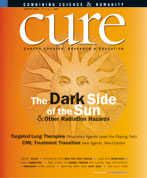Preventing Exposure
Tips on how to prevent exposure to radon in your home, UV rays from the sun, and radiofrequency from cell phones.
> Check your home for radon. The EPA says immediate repair is needed if a simple radon home kit (available in hardware stores and through its organization) shows a house has radon levels of 4 picocuries or higher. Information is also available by calling the National Radon Information Line at 800-SOS-RADON (767-7236). Discounts on radon home kits are available at www.epa.gov and through the toll-free number. For those who need information about radon mitigation, call the Radon Fix-It Program at 800-644-6999.
> UV-free methods exist for getting a tan, including the well-known tanning creams found at any drugstore or makeup counter. The newest craze is the spray tan, where the user is sprayed with an FDA-approved substance. Also available are tanning pills, which contain color additives. Because of side effects, including impaired vision, the American Cancer Society discourages use of tanning pills.
> The EPA and the National Weather Service revamped their UV Index system this past spring to include a UV alert system (accessible at www.epa.gov) that employs color-coding for exposure levels on any given day.
> If you are concerned about radiofrequency exposure from a cell phone, hands-free kits are available. For most phones, you can check the specific absorption rate value of your particular phone model by visiting www.fcc.gov/cgb/sar.
> Find a CT-accredited location in your area by visiting the American College of Radiology’s website at www.acr.org. Because of the program’s voluntary nature, few places are currently accredited. But at accredited locations, you can be confident that the dose has been measured properly and the image quality of the CT scan has been optimized. Accredited facility searches can also be done for mammography, MRI, PET and radiation oncology, among others.
> Keep a log of the medical tests you have done. If a physician orders a particular imaging test, pull out your log and ask if previous tests can be used instead. Added plus: It not only keeps you from being exposed, it also saves you money.
